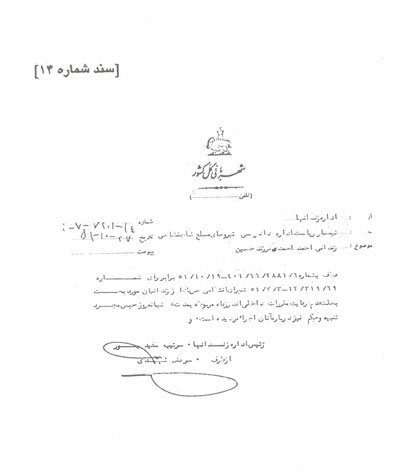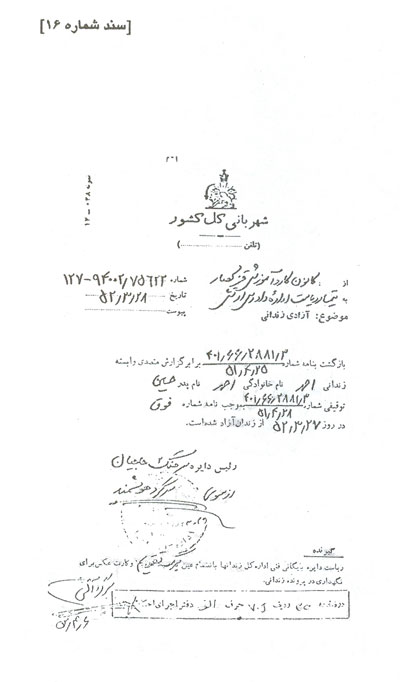Ahmad Ahmad Memoirs (41)
Edited by Mohsen Kazemi
Ahmad Ahmad Memoirs (41)
Edited by Mohsen Kazemi
Soureh Mehr Publishing Company
(Original Text in Persian, 2000)
Translated by Mohammad Karimi
Qezel Hessar Prison (1) and Freedom Again
Mehdi Rezaee was executed on September 7th 1972. We decided to hold a meeting in memory of him in the big room known as “Gathering Room” (2). In this meeting Ayatollah Anvari stood at the door to welcome others as the host.
Group of Marxists reported the news of this meeting to SAVAK. After many interrogations SAVAK arrested 5 people who had the main role for holding this meeting (Ahmad Shah Bodaghlou, Hussein Husseini-Zadeh, Abulqasem Sarhaddi-Zadeh, Seyyed Mohammad Kazem Mousavi Bojnourdi and I) and put them all in solitary confinement for five days and nights. Then they formed a council and then decided to send each of us to exile. Since there was only 9 months remained of my imprisonment verdict, they sent me to Qezel Hessar Prison in order not to be far for later decisions. (Documents 14 and 15)


In Qezel Hessar Prison they took me to political prisoners’ row. When I entered the row, I suddenly saw Nasser Naraghi right in front of me. He was shocked and said: “Oh God! Mr. Ahmad! ...” and began kissing and greeting.
Then he took me to his room. Mohammad Hassan Ebn-ul-Reza (3) was also there. We became so happy to see each other. Later I found out from Islamic Councils Coalition Members that the late Assadollah Lajdevardi (4) was also there.
The next day I saw some interesting scenes. There was no distinction between the Muslim and Marxist prisoners just unlike the Qasr Prison. I asked the reason from Ladjevardi. He said: “Here the conditions are very bad and we necessarily should pretend about religious matters to avoid conflict.
Muslims were a minority in Qezel Hessar and consequently they would avoid any face to face conflict with Marxists or even MKO members. In cases that Muslims would clearly oppose the Marxists they would severely hurt them; so, Muslims would keep some kind of controlled contacts with Marxist while trying to obey their own religious rules.
I followed my own program for worshiping, study and gym. I also began crochet under the supervision of the late Ladjevardi and in a short time I could knit some good nets.
It was in this prison that I acquainted with Mohsen Tarighat, Farhad Safa, Seyyed Ali Seyyed Ahmadian and Abbass Davari and began studying the MKO ideological principals and for a better understanding and getting better information and analysis in this regard, I would take part in the classes by Dr. Seyyed Ahmad Tabatabai.
In order to keep ourselves away from Marxists because religious reasons, we would arrange the programs in prison in a way that Muslim could get and deliver the food among all. However, it did not take long and the Marxists found our trick. So they would go and get their own food to compensate what we did to them. So,then we would not eat that food and feed on breads only.
About a month later, the late Ladjevardi voluntarily transferred to Mashhad Prison to join Habibullah Asgar-owladi and Abolfazl Heydari who had been exiled there some time before. After his leave, we lost a strong pall in prison.
A very constructive program in prison was fasting. Most of the Muslim prisoners were fasting during three months of Rajab, Sha’ban and Ramadan. This fasting was more political than religious and would help us to avoid eating and drinking with the Marxists. After 80 days of fasting, my allergy to smells flared up; it was a sickness that I got infected in Evin Prison. It was so strange. I was even allergic to water smell.
I could not eat anything anymore, even water or bread. It was horrible situation and I was getting worse day by day. I was going to die. However, by my friends’ help in avoiding eating smelly foods, I got better and kept that way of behavior in eating. I would not come out of my cell and row in spring in order not to smell the flowers’ fragrance and entertain myself by reading books inside my cell.
I passed my last days of imprisonment by all those usual programs and tolerating my allergy. Finally I was freed on June 17th 1973. (Document 16)

During my days in prison, my family had sold their old house and bought a new house by the help of my uncle near Lashgar Crossroads. So, after freedom I came into a new house for the first time.
Hezbollah and MKO Unity
We had saved the group that we had shaped with holy goals from the hands of SAVAK despite heavy tortures. However, when Abbass Agha Zamani went abroad and I was imprisoned, Javad Mansouri became a minority the central cadre of the party and move its way to a wrong one and finally its death came.
MKO was about to collapse after its heavy defeat in September 1971 when many of its leadership members were arrested and many others were wanted by SAVAK. Right at this time and individual named Mostafa Javan Khoshdel who had been connected to Hezbollah through Ali Reza Sepassi, asked help from the party.
Hezbollah hid some of wanted MKO members and followers in its secret team-houses. Then it began publishing MKO pamphlets and announcements with its limited facilities.
It was the beginning point for the fall of Hezbollah. This fall or collapse for Hezbollah was complete when it was decided to join MKO. There was conflicting viewpoints among its members. It is said that when joining MKO question was presented by some members, Javad Mansouri severely had opposed it and got out of Hezbollah. Some like Ali Reza Sepassi and Mohammad Mofidi remained in Hezbollah and joined MKO. Ali Reza Sepassi was among the ones who could rise in organizational ranks so fast. Later he became one of main founders of Marxist branch of MKO, Peykar Organization led by Mohammad Taqi Shahram. (5)
1- Qezel Hessar Prison is located in Karaj.
2- “Gathering Room” was bigger than other rooms in the row. So, most of the meetings and ceremony would be held there. In some prisons this kind of ceremonies would be held in the cells of prominent prisoners.
3- Seyyed Mohammad Hassan Ebn-ul-Reza son of Seyyed Abulfazl was born in 1946 in Qanat-Abad quarter in Tehran. He grew up in family who had interests in Islamic Devotee Community (Fada’iyan-e Eslam), the late Navab Safavi and the late Vahedi Alayeghi. Mohammad Hassan took part in Ashura demonstrations in 1963. After getting his diploma he became a teacher. He would spend part of his class hours to represent political issues. In the spring of 1965 he became a member of INP and when this party was revealed in October 1965, he was arrested and sentenced to 8 years in prison. He passed bad days as part of his verdict in Sari in exile. After freedom in 1973 he supported the fight against the Pahlavi regime till victory of Islamic movement.
4- The late Assadullah Ladjevardi was born in Tehran in 1935. He passed elementary school and then took part in religious classes by the late Hojatuleslam Seyyed Ali Shahcheraghi. He had to work to in bazaar of Tehran to feed his family. In 1963 he became a member of the central council of Islamic Councils Coalition. A year later, he was arrested in relation with the assassination of Hassan Ali Mansour and sentenced to two years in prison. During the football match between Iran and Israel national teams, he was one of the bombers in El Al aviation office. So he was arrested and sentenced to 4 years in prison. He was heavily tortured and lost part of his sight and his back was also hurt. He passed his verdict in Qezel Qa’eh, Qasr, Qezel Hessar and Mashhad prisons. When open political space was represented he was freed on August 18th 1977. The late Ladjevardi joined the Welcoming Committee for Imam Khomeini Coming back home in 1979. After the Islamic Revolution victory, he served in different posts such as Islamic Revolutionary Prosecution and Head of National Organization of Prisons and finally he was assassinated by MKO elements in summer of 1998.
5- In this regard Mr. Ahmad added for the 10th reprint of the book: “I was aware of conflicts in Hezbollah after the Islamic Revolution. If I were aware at the same time, I might have been able to change the path of the fights in this party.”
Number of Visits: 6021








The latest
Most visited
- Third Regiment: Memoirs of an Iraqi Prisoner of War Doctor – 8
- The 372nd Night of Memoires– Part 2
- The Role of Objects in Oral Narrative
- 100 Questions/ 8
- Pak-Setan (Clean-Seeker)
- Third Regiment: Memoirs of an Iraqi Prisoner of War Doctor – 9
- The Relationship between “Religious Jurisprudence” and “Oral History”
- Oral History News – Aban 1404
Challenges of Interviewing in Oral History
After years of studying the theoretical foundations of oral history, conducting numerous interviews and going through their post-interview stages, as well as reading the available body of oral history literature, I was eventually given the opportunity to evaluate the edited versions of dozens of oral history projects.Comparing the Narratives of Commanders and Ordinary Combatants in the Sacred Defense
An Analysis of Functions and ConsequencesThe experience of the Sacred Defense cannot be comprehended merely through statistics or official reports; what truly endures from war are the narratives of those who stood upon its frontlines. These narratives, however, vary significantly depending on one’s position, responsibilities, and lived experience.
Unveiling of the book "Oral History: What and Why"
The First report: Alireza KamariAccording to the Oral History website, the unveiling ceremony of the book "Oral History: What and Why" by Hamid Qazvini was held on Sunday evening, November 24, 1404, in the presence of experts in the field of oral history in the Salman Farsi Hall of the Arts Center.


